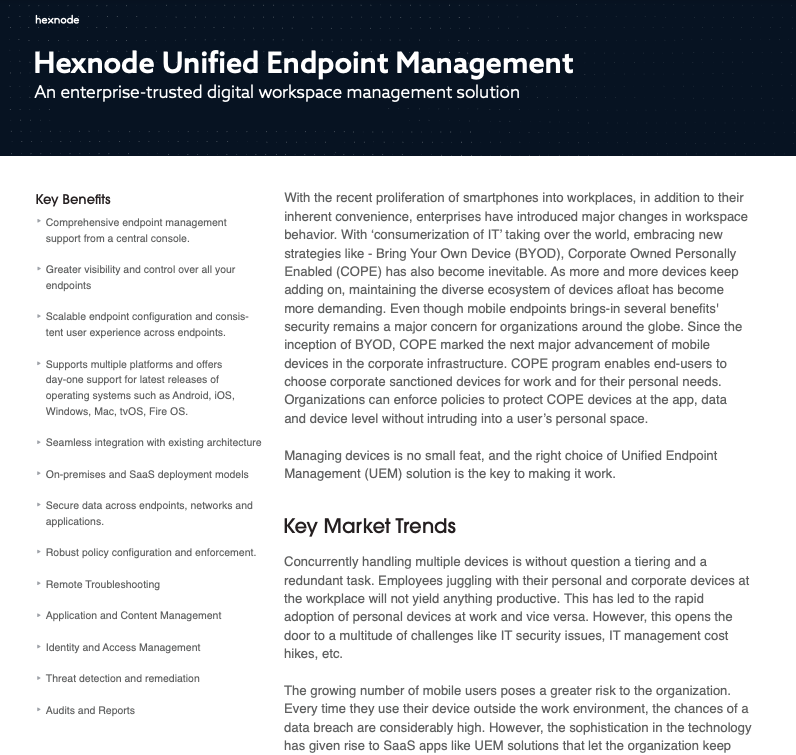- Significance of ROI
- Measuring the ROI of mobile workforce
- Change in expense vs change in revenue
- The productivity of the workplace
- Accuracy at work
- Adaptability
- Data analysis for decision making
- Customer satisfaction
- How the UEM solution can enhance the ROI of your mobile workforce
- Featured Resource
- Hexnode Unified Endpoint Management
- Conclusion
The mobile workforce works beyond a specific office site but is not confined to working from home. It reflects the transition to data and geographic mobility to support the “anytime, anyplace” aspect of modern work. Working from a mobile device nowadays entails far more than just reading company email and talking via chats. Cloud technology has aided in this huge change, and today, employees access the data saved in the cloud from anywhere to stay connected while being mobile. Thus understanding and analyzing the Return on Investment or ROI of mobile workforce is a critical factor in modern businesses.
Significance of ROI
The ROI of mobile workforce is an important indicator to test its effectiveness. With an increasing number of businesses depending on the mobile workforce to provide their products and services, it is critical to understand and evaluate its ROI. It will help you evaluate the cost incurred to deploy the workforce, its impact on the business and whether it is a sustainable approach. By measuring ROI, you will have a better understanding of how well your firm is performing and which aspects could require attention to help you meet your objectives.
Measuring the ROI of mobile workforce
Measuring the ROI of mobile workforce is not just measuring expense and revenue. To understand the return on investment made, multiple metrics are taken into consideration. They reflect whether you’re making the best possible return on the workforce mobility investment. Several of these attributes are fairly measurable, while others are more difficult to nail down. The following metrics were found to be some of the most important ones to conclude:
Change in expense vs change in revenue
Although it is not the only factor, it is certainly one of the prime reasons behind implementing the workforce in the first place. The organization needs to compare if the increased expense provides much higher revenue. Another significant cost-cutting advantage of a mobile workforce is reduced infrastructure and storage. Businesses that migrate to the cloud eliminate the need to buy, store, and manage physical infrastructure. Even the time that is saved upon implementing a mobile workforce should also be considered. The business will be profitable only when the revenue generated is higher than the cash burnt.
The productivity of the workplace
Whether directly or indirectly, the sole purpose of bringing any change to the workplace is to increase productivity. Individuals who can safely access both personal and business material on a single system are well positioned to reap the benefits of a mobile workforce’s productivity increase. With more millennials joining the labour force every year. their desire of workplace flexibility by utilizing technology will enable them to operate outside of the typical office environment and boost productivity.
Accuracy at work
Working with a mobile workforce aid in the automation of numerous operations, which reduces mistakes, streamlines processing, and enhances record keeping. It also lowers the time a team takes to offer services and goods while also saving money and simplifying the task. The more the accuracy of the work, the higher the efficiency and the better the ROI on your mobile workforce.
Adaptability
When an organization shifts to a cloud platform, the employees have to adapt themselves according to the company’s needs. Using apps that are simple to understand and work with can benefit your staff, resulting in higher employee efficiency and profits, thus boosting the ROI of the workforce. The mobile workforce should also allow you to access a much larger talent pool with no location constraints. Businesses can then employ from all around the country, and in certain situations, the world.
Data analysis for decision making
Analyzing the usage data may give crucial insight into the usefulness of the workforce. Data-driven decision-making is essential for overseeing a mobile workforce. To make key decisions, managers can study data elements such as travel duration, appointment length, and survey findings about consumers and staff. Sometimes, understanding metrics like time spent or saved with an app, and simplicity of use, among others, may provide you with the standards you need to iterate and enhance your mobile strategy and, ultimately, your ROI.

Customer satisfaction
One of the most crucial metrics for any business is customer happiness and satisfaction. It is difficult to segregate the other metrics from customer happiness as most of the decisions revolve around making the customer satisfied. If clients are generally satisfied with the solutions and goods you offer, it is a strong indicator that your mobilization efforts are paying off. Increased customer satisfaction leads to an increase in revenue which means a better ROI.
How the UEM solution can enhance the ROI of your mobile workforce
Working remotely and using personal devices for work raises security concerns. Personal phones that contain workplace data are equally vulnerable to cyberattacks as work computers left alone in a café or linked to a public Wi-Fi network. There is also potential that the gadget in use will be stolen. Managing multiple devices remotely also becomes a challenge in such a scenario.
To address these kind of problems, UEM solutions like Hexnode have come up with multiple features like enforcing bulk app deployments on multiple devices at once, setting up a VPN policy that enables strong encryption even over insecure networks to protect enterprise data, allowing IT admins to remotely delete hard drives if your phone or laptop is stolen, and many more. Hexnode provides secure data access and communication with better connectivity, admins can monitor devices in real-time, track their location, etc. They also provide real-time assistance and helps to boost the productivity using the kiosk mode features. The solutions offered by a UEM software will thus have a significant impact on the ROI of the workforce.
Hexnode UEM allows smooth device onboarding, seamless administration, kiosk management and much more. Its high scalability, multi-platform support helps manage BYO devices and COPE devices with ease.

Featured Resource
Hexnode Unified Endpoint Management
Conclusion
The pros and cons of every decision are carefully weighed before putting them into action. In this case, the investment in deploying a mobile workforce and the return on the investment are evaluated. Although numerous other factors can be used to evaluate ROI, the above six are found to be the most critical ones. The ROI also helps to determine the profitability of the business.
Not all metrics are quantifiable and we also found that not all metrics are independent of each other. Increased productivity and effectiveness help in reaching out to more customers and provide them with a better experience. This results in higher revenue and might positively impact the profitability of the business. Thus, the ROI of mobile workforce is one of the key indicators in deciding its requirement and if it will be sustainable.




![[Infographic] Empower your mobile workforce with the feature-rich Hexnode MDM solution](https://cdn.hexnode.com/blogs/wp-content/uploads/2020/10/MDM-solution-1024x683.jpeg?format=webp)

